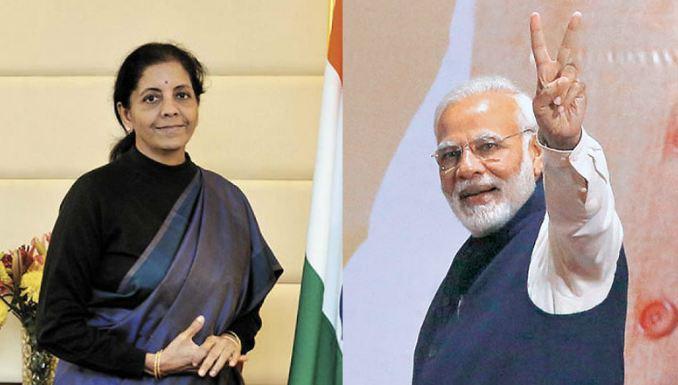COVID-19 Lockdown: Unbearable Half Measures of Modi Government

Prime Minister Modi suddenly announced a 21-day lockdown on March 24 across India as a rather belated and overwrought response to the looming coronavirus disease (COVID-19) that has now spread around the world in 175 countries, striking at over 4.75 lakh persons (confirmed) and killing over 21,000.
Two days later, on March 26, Finance Minister Nirmala Sitharaman announced a package of financial measures mainly directed at providing some relief to poorer and disadvantaged sections of the people. At a press conference in New Delhi, she claimed that this package would entail spending of Rs. 1.7 lakh crore under a new programme called Prime Minister Garib Kalyan Yojna. It will offer relief to 80 crore people, according to her, and would take effect immediately.
In brief, the announcements include: increase of MGNREGA wages from Rs 182 to Rs 202 per day; transfer of Rs 2,000 to all farmers registered in the income support scheme (PM-KISAN); transfer of Rs 500 per month (for three months) to every woman account holder under the Jan Dhan Yojana; ex-gratia grant of Rs 1,000 to poor senior citizens, poor widows and poor disabled; free gas cylinders to all Ujjwala beneficiaries. Besides these, some other measures announced include payment of EPF contributions of both employees and employers (for three months) in units with less than 100 workers and 90% workforce earning less than Rs 15,000 per month; collateral-free loan doubled to ₹20 lakh to 63 lakh for women self-help groups; and non-refundable advance from EPF upto 75% of the amount.
She also announced that each BPL PDS card holder will get additional 5 kg of wheat or rice per person and 1 kg of dal per family for the next three months.
To repeated questions in the press meet, the FM refused to clarify where this money was coming from, although she had mentioned earlier that various funds like the Building and Construction Workers’ Fund, and the District Mineral Fund will be put into play.
While these measures – especially those that directly go to the poorer families – will indeed provide relief in a time when an estimated 75% of economic activity has ground to a halt, the package also suffers from the usual features that mark the present government’s approach towards problems of the people. These typically include, late thinking and scrambling to fire fight (remember demonetization?), partial measures, fiddling around with finances rather than boldly spending money, and most importantly, leaving several other gigantic problems unaddressed – perhaps to be tackled after more damage and more delay. Let’s have a look at these, starting with the unaddressed problems.
Forgotten Rabi Harvest
Wheat, mustard, various pulses are ripe and ready to be harvested across the country, or will be ready in a couple of weeks. The lockdown means that farmers cannot hire sufficient workers, nor mobilise family and friends, to harvest the ready crops. Already, there are reports of farmers violating the lockdown rules in order to start harvesting.
So, what are they supposed to do? Allow the standing crop to rot in the fields? That they will never allow to happen – it’s the farmers’ life blood. A mere Rs 2,000 per family that is being offered is nothing compared to the value of the crop. There are rumours that the government will exempt agricultural operations, but nothing is confirmed. Doesn’t this remind you of the demonetisation dithering? With the same devastating effects?
Also watch: Will Modi's Relief Package Save the Poor?
Even if the farmers harvest the crop, they will need to process it (threshing, winnowing, etc.) and then take it to nearby grain markets to sell, either to the government procurement agencies or to traders, as the case may be. Again, how are they supposed to do all that under the lockdown?
A real boon for farmers would have been the government procurement straight from the villages, or clusters of villages. It's not as if it can’t be done: in Punjab, very often this is the way wheat is procured. But the government needs to organise the whole exercise. This would prevent farmers from travelling to crowded mandis (APMCs) and continuing transmission of the coronavirus. But, the government thinks its job is done after doling out Rs 2,000.
The Great MGNREGA Wage Hoax
This could easily be the biggest sleight of hand in the exercise. What has been announced is a hike in wages – amounting to Rs 20 per day.
When the FM claims that each worker in the rural jobs guarantee scheme will thus get Rs 2,000 more, she has created a bogus image. That much extra would be earned if 100 days work is done. Actually, as per the rural development ministry data, average number of days worked in a year is 48 in the current year. Last year it was 51 days. For the past several years it has hovered around this. So, there is no question of workers getting Rs 2,000 extra.
In any case, wages are delayed inordinately, year after year. They may be delayed by as many as 45 days. What will be the use then? According to reports, on January 27 this year, 91% of wages due in that month, amounting to over Rs 2,803 crore were pending. For the previous month of December 2019, 53% wages were pending. That gives an indication of the kind of delays taking place.
In any case, the whole benefit from hike in wages is notional because unless work is offered, there will not be any wages paid – and no benefit. In a lockdown, will work be offered at all? Very unlikely.
A far better method would have been to simply transfer all the pending wages, and add a substantial amount to it – say, Rs 3000, at least. That would be a grant, a social assistance given to the most needy.
Rs 500 Enough to Run a Household?
A strange decision – and a tragically squandered opportunity – is the transfer of Rs 500 to each woman Jan Dhan account holder. She is supposed to manage the household in Rs 500 per month? Are we living in the mid twentieth century?
Only the farmers’ families could get Rs 2,000. Of course, wheat (or rice) and dal would be available. But all the other needs of the family? From cooking oil to vegetables, from house rent to medicines, from milk to masalas – all in Rs 500?
Since the accounts have already been opened and the financial transfer mechanism is available, the government could have easily transferred a larger amount that would really bring relief in these difficult times.
The provision of free gas cylinders will be a big relief, as long as the supply is ensured. Average use of Ujjawala cylinders is about 6 per year. So, in this three-month period, perhaps two cylinders will be used up. That would be a relief, but not substantial.
But optics seems to be the more preferred choice. And that’s why the numbers of every benefit scheme are added cumulatively to claim that 80 crore people will benefit. In reality, some may have two benefits coming in while others will have none. So move the wheels of justice in Modi’s aegis.
Just Rs 1,000 for Older People or Differently Abled
This is similar to the Rs 500 for women. Except that the amount of Rs 1000 is one-time only and not monthly. Now, a destitute widow, or a physically challenged man who survives on alms – how are they supposed to survive with Rs 1000 for, say, the next three months? Whatever they did to eke out an existence, beg or work as maids or just depend on the goodwill of families or others – that may vanish in this lockdown.
Remember, these people will also have the highest risk of getting COVID-19. They are seniors, they meet others constantly, and probably suffer from other diseases too – all high risk factors.
Any compassionate government – as the present one claims to be – would have announced a larger amount and accompanied it with other medical, social and economic measures. But the thinking here seems to be that throw money at the problem, and head for the nearest exit, with applause in the background.
In sum, the ill-conceived package will bumble through India’s bureaucracy and digital transfer channels, reaching some of the poorest sections, giving a miss to others, giving some relief and succor, but never being sufficient. It is another of Modi’s public relations exercises. It would be interesting to compare this to the kind of concessions that will be doled out to the corporate world in the coming days…
Also read: Woman with No Travel History Dies of COVID-19 in Indore, Cases Rise to 20 in MP
Get the latest reports & analysis with people's perspective on Protests, movements & deep analytical videos, discussions of the current affairs in your Telegram app. Subscribe to NewsClick's Telegram channel & get Real-Time updates on stories, as they get published on our website.
























